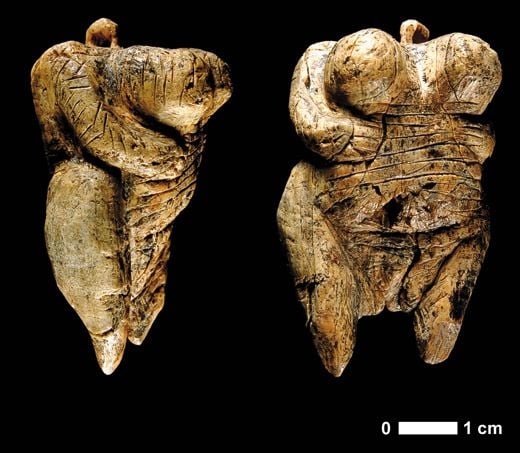The Cave Art Debate
The discovery of a 40,000-year old figurine reignites debate among archaeologists about the origins—and true purpose—of art
The oldest sculpture of a human being is so small it could be hidden in your fist. Carved out of mammoth ivory, the 40,000-year-old figurine clearly represents a woman, with ballooning breasts and elaborately carved genitalia. The head, arms and legs are merely suggested. “You couldn’t get more female than this,” says Nicholas Conard, the Ohio-born archaeologist whose University of Tübingen team found the sculpture at the bottom of a vaulted cave in southwestern Germany in the fall of 2008. “Head and legs don’t matter. This is about sex, reproduction.”
The discovery of the “Venus of Hohle Fels”—named by Conard for the cave where it was found—made news around the world. Headlines called the busty statuette “prehistoric porn.” But the Venus renews a serious scholarly debate that has flared now and then since Stone Age figurines—including a waterfowl, lions and mammoths—were first discovered early last century at Hohle Fels and nearby caves. Were these literal representations of the surrounding world? Or artworks created to express emotions or abstract ideas?
Some experts viewed such pieces as “hunting magic”—representations of sought-after game animals and, therefore, survival tools, not works of art. The problem is, many of the figurines discovered so far—predators such as lions and bears—don’t correspond to what prehistoric people ate. (Their diet consisted largely of reindeer, bison and horse meat, according to bones that archaeologists have found.) Others perceive some prehistoric figurines—including a half-lion, half-man —not as imaginative works but literal depictions of hallucinations experienced by tribal shamans.
The Venus has prompted new thinking, encouraging some scholars to focus on what the figure tells us about prehistoric perceptions of beauty and obesity. Anthropologists at Victoria University of Wellington, New Zealand, recently published a study arguing that corpulent figurines symbolized the hope for a well-nourished community.
For his part, Conard emphasizes the significance of the figurine’s exaggerated anatomical features. “This is an extremely powerful depiction of the essence of being female,” Conard tells Smithsonian. He’s convinced the artifacts from these caves—regardless of whether they are art or talismans—mark a milestone in human development, an intense flowering of creativity that began in the region more than 35,000 years ago. Within a few thousand years, he says, this impulse spread to Stone Age France and Spain—where it turns up in paintings of bison, rhinos and lions on the walls of caves like Chauvet and Altamira.
University of Illinois archaeologist Olga Soffer doubts that we’ll ever know the true nature of these creations, and cautions against speculating about prehistoric imagery in terms of “18th-century Western European art.” But, art or not, Conard emphasizes that Stone Age sculptors imbued their work with larger meaning.“They’re talking about something other than their daily lives.”
/https://tf-cmsv2-smithsonianmag-media.s3.amazonaws.com/accounts/headshot/SQJ_1604_Danube_Contribs_02.jpg)

/https://tf-cmsv2-smithsonianmag-media.s3.amazonaws.com/accounts/headshot/SQJ_1604_Danube_Contribs_02.jpg)